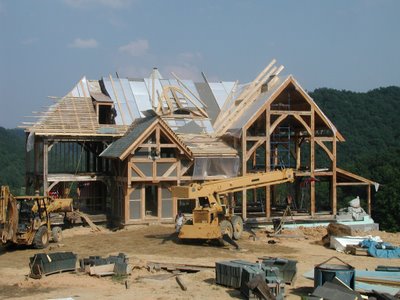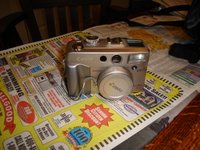
In
part one of "The Real DIY Flooring" we left off with the rough sawn 1x4 and 1x6 boards dry and in the house to acclimate while I was
out of town.
While gone Coleman was set up to plane all the boards to 7/8ths of an inch. The set up was pretty basic with a
Delta 12 1/2 inch planer attached to a dust collector. The dust collector is essential since it pulls all the chips from the planer but it fills up after about 12 boards are passed through it. An in-feed and out-feed roller was set up so while one board was going through the next could be picked out and started. It can easily turn into a scene from Laverne and Shirley on

the bottling line when things get out of control ...
......get the first board going ... watch it ... select the next ... start it going towards the end of the previous one ... watch the one coming off ... stack the boards ... select the next board ... check thickness using the caliper.....
When I got back it was great to see all the boards planed and sorted by size. Coleman did a great job! There was a small reject pile of twisted and thin boards but all in all they were great.
So from tree to floor you are talking about 50 to 100 ft of travel!Next step in the process was to nail the boards down. We are face nailing the boards with old time looking cut nails. 2 1/2" nails over floor joists and 1 1/2 " nails when board ends meet not over a joist. Each board gets 2 nails every 16 ". That is a lot of nailing and a lot of sore thumbs. One trick we used was needle nose pliers to hold the 1 1/2" nails to protect against injured thumbs. We ended up driving lots of nails.

To help eliminate squeaky floors we placed 15 lb tar paper on the subfloor (3/4 " T&G OSB glued and nailed to the joists) and snapped chalk lines where the joists were. We also used pipe clamps to put the boards tight. They still have a bit of moisture in them so they will shrink instead of expand. I found that the best way to put the boards down was to cut 3 to 4 rows and set them in place then clamp and nail. If Coleman was working with me I would get the boards placed and 1/2 the nails in and then he could fill in nail later.
The final step for now was to cover the floors with rosen paper to protect them while we finish the remainder of the interior. We are going to oil them once we are just about done with the house. You may wonder why we are doing the floors before the drywall etc. Given that the radiant tubing is under the floors we wanted to be able to check the tubing if there were any nails that missed the floor joists and hit the tubes. We are happy to report that tubes are unharmed and still under pressure.
To be continued .... Also look for future postings titled "The Real DIY Siding"












